Kyrre Glette
More complex environments may be required to discover benefits of lifetime learning in evolving robots
Dec 11, 2024Abstract:It is well known that intra-life learning, defined as an additional controller optimization loop, is beneficial for evolving robot morphologies for locomotion. In this work, we investigate this further by comparing it in two different environments: an easy flat environment and a more challenging hills environment. We show that learning is significantly more beneficial in a hilly environment than in a flat environment and that it might be needed to evaluate robots in a more challenging environment to see the benefits of learning.
Behaviour diversity in a walking and climbing centipede-like virtual creature
Nov 19, 2024Abstract:Robot controllers are often optimised for a single robot in a single environment. This approach proves brittle, as such a controller will often fail to produce sensible behavior for a new morphology or environment. In comparison, animal gaits are robust and versatile. By observing animals, and attempting to extract general principles of locomotion from their movement, we aim to design a single decentralised controller applicable to diverse morphologies and environments. The controller implements the three components 1) undulation, 2) peristalsis, and 3) leg motion, which we believe are the essential elements in most animal gaits. The controller is tested on a variety of simulated centipede-like robots. The centipede is chosen as inspiration because it moves using both body contractions and legged locomotion. For a controller to work in qualitatively different settings, it must also be able to exhibit qualitatively different behaviors. We find that six different modes of locomotion emerge from our controller in response to environmental and morphological changes. We also find that different parts of the centipede model can exhibit different modes of locomotion, simultaneously, based on local morphological features. This controller can potentially aid in the design or evolution of robots, by quickly testing the potential of a morphology, or be used to get insights about underlying locomotion principles in the centipede.
Co-Optimization of Robot Design and Control: Enhancing Performance and Understanding Design Complexity
Sep 13, 2024Abstract:The design (shape) of a robot is usually decided before the control is implemented. This might limit how well the design is adapted to a task, as the suitability of the design is given by how well the robot performs in the task, which requires both a design and a controller. The co-optimization or simultaneous optimization of the design and control of robots addresses this limitation by producing a design and control that are both adapted to the task. In this paper, we investigate some of the challenges inherent in the co-optimization of design and control. We show that retraining the controller of a robot with additional resources after the co-optimization process terminates significantly improves the robot's performance. In addition, we demonstrate that the resources allocated to training the controller for each design influence the design complexity, where simpler designs are associated with lower training budgets. The experimentation is conducted in four publicly available simulation environments for co-optimization of design and control, making the findings more applicable to the general case. The results presented in this paper hope to guide other practitioners in the co-optimization of design and control of robots.
Design and Fabrication of Soft Locomotion Robots based on Spatial Compliant Mechanisms
Aug 09, 2024Abstract:Soft robotics has emerged as a promising technology that holds great potential for various application areas. This is due to soft materials unique properties, including flexibility, safety, and shock absorption, among others. Despite many advancement in the field, the development of effective design methodologies and production techniques for soft robots remains a challenge. Although numerous robot prototypes have been proposed in recent years, their designs are often complex and difficult to produce. As such, there is a need for more efficient and unified design approaches that can facilitate the production of soft robots with desirable properties. In this paper, we propose a method for designing soft robots using elastic beams and spatial compliant mechanisms. The method is based on an evolutionary approach that enables the creation of designs with both high motion and force transmission ratios. Specifically, we focus on the development of locomotion mechanisms using a central linear actuator. Our approach involves the use of commonly available plastic materials and a 3D printer to manufacture the designs. We demonstrate the feasibility of our approach by presenting experimental results that show successful production and real world operation. Overall, our findings suggest that the use of elastic beams and an evolutionary approach can facilitate the creation of soft robots with desirable locomotion properties, including fast locomotion up to 3.7 body lengths per second, locomotion with a payload, and underwater locomotion. This method has the potential to enable the development of more efficient and practical soft robots for various applications.
LVNS-RAVE: Diversified audio generation with RAVE and Latent Vector Novelty Search
Apr 22, 2024



Abstract:Evolutionary Algorithms and Generative Deep Learning have been two of the most powerful tools for sound generation tasks. However, they have limitations: Evolutionary Algorithms require complicated designs, posing challenges in control and achieving realistic sound generation. Generative Deep Learning models often copy from the dataset and lack creativity. In this paper, we propose LVNS-RAVE, a method to combine Evolutionary Algorithms and Generative Deep Learning to produce realistic and novel sounds. We use the RAVE model as the sound generator and the VGGish model as a novelty evaluator in the Latent Vector Novelty Search (LVNS) algorithm. The reported experiments show that the method can successfully generate diversified, novel audio samples under different mutation setups using different pre-trained RAVE models. The characteristics of the generation process can be easily controlled with the mutation parameters. The proposed algorithm can be a creative tool for sound artists and musicians.
Open-ended search for environments and adapted agents using MAP-Elites
May 02, 2023Abstract:Creatures in the real world constantly encounter new and diverse challenges they have never seen before. They will often need to adapt to some of these tasks and solve them in order to survive. This almost endless world of novel challenges is not as common in virtual environments, where artificially evolving agents often have a limited set of tasks to solve. An exception to this is the field of open-endedness where the goal is to create unbounded exploration of interesting artefacts. We want to move one step closer to creating simulated environments similar to the diverse real world, where agents can both find solvable tasks, and adapt to them. Through the use of MAP-Elites we create a structured repertoire, a map, of terrains and virtual creatures that locomote through them. By using novelty as a dimension in the grid, the map can continuously develop to encourage exploration of new environments. The agents must adapt to the environments found, but can also search for environments within each cell of the grid to find the one that best fits their set of skills. Our approach combines the structure of MAP-Elites, which can allow the virtual creatures to use adjacent cells as stepping stones to solve increasingly difficult environments, with open-ended innovation. This leads to a search that is unbounded, but still has a clear structure. We find that while handcrafted bounded dimensions for the map lead to quicker exploration of a large set of environments, both the bounded and unbounded approach manage to solve a diverse set of terrains.
Evolution of linkages for prototyping of linkage based robots
May 02, 2023Abstract:Prototyping robotic systems is a time consuming process. Computer aided design, however, might speed up the process significantly. Quality-diversity evolutionary approaches optimise for novelty as well as performance, and can be used to generate a repertoire of diverse designs. This design repertoire could be used as a tool to guide a designer and kick-start the rapid prototyping process. This paper explores this idea in the context of mechanical linkage based robots. These robots can be a good test-bed for rapid prototyping, as they can be modified quickly for swift iterations in design. We compare three evolutionary algorithms for optimising 2D mechanical linkages: 1) a standard evolutionary algorithm, 2) the multi-objective algorithm NSGA-II, and 3) the quality-diversity algorithm MAP-Elites. Some of the found linkages are then realized on a physical hexapod robot through a prototyping process, and tested on two different floors. We find that all the tested approaches, except the standard evolutionary algorithm, are capable of finding mechanical linkages that creates a path similar to a specified desired path. However, the quality-diversity approaches that had the length of the linkage as a behaviour descriptor were the most useful when prototyping. This was due to the quality-diversity approaches having a larger variety of similar designs to choose from, and because the search could be constrained by the behaviour descriptors to make linkages that were viable for construction on our hexapod platform.
Central pattern generators evolved for real-time adaptation
Oct 14, 2022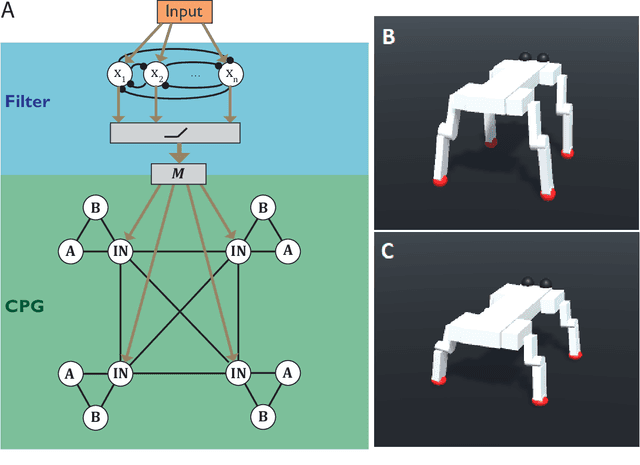

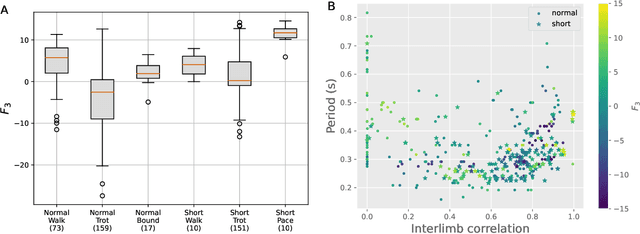
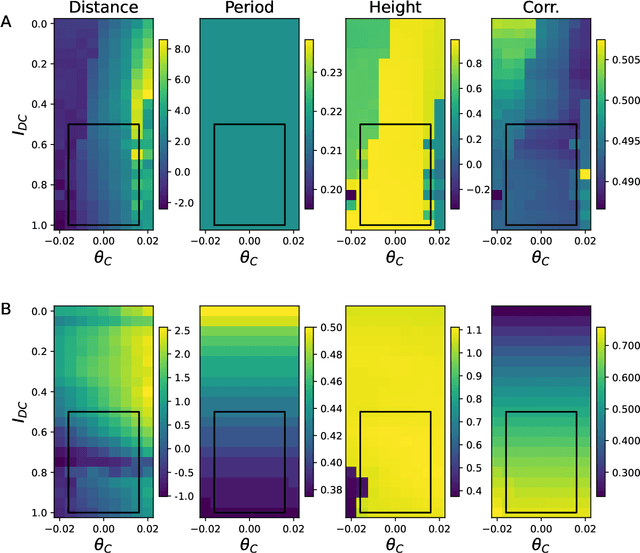
Abstract:For a robot to be both autonomous and collaborative requires the ability to adapt its movement to a variety of external stimuli, whether these come from humans or other robots. Typically, legged robots have oscillation periods explicitly defined as a control parameter, limiting the adaptability of walking gaits. Here we demonstrate a virtual quadruped robot employing a bio-inspired central pattern generator (CPG) that can spontaneously synchronize its movement to a range of rhythmic stimuli. Multi-objective evolutionary algorithms were used to optimize the variation of movement speed and direction as a function of the brain stem drive and the center of mass control respectively. This was followed by optimization of an additional layer of neurons that filters fluctuating inputs. As a result, a range of CPGs were able to adjust their gait pattern and/or frequency to match the input period. We show how this can be used to facilitate coordinated movement despite differences in morphology, as well as to learn new movement patterns.
Centralized and Decentralized Control in Modular Robots and Their Effect on Morphology
Jun 27, 2022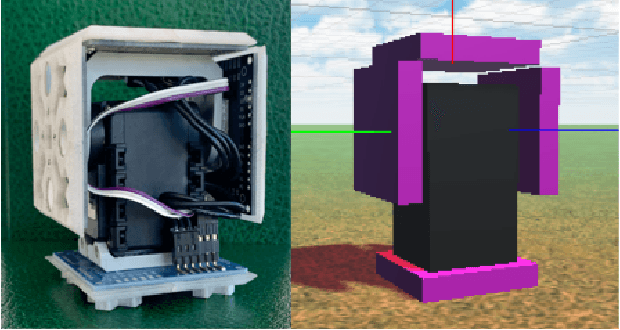

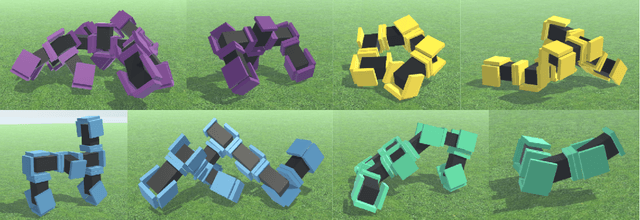
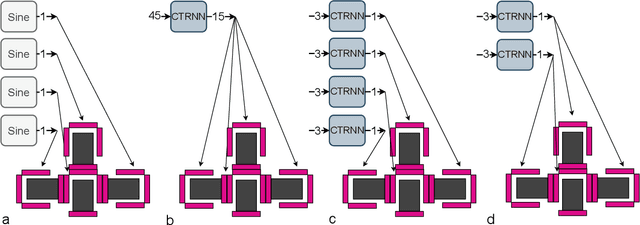
Abstract:In Evolutionary Robotics, evolutionary algorithms are used to co-optimize morphology and control. However, co-optimizing leads to different challenges: How do you optimize a controller for a body that often changes its number of inputs and outputs? Researchers must then make some choice between centralized or decentralized control. In this article, we study the effects of centralized and decentralized controllers on modular robot performance and morphologies. This is done by implementing one centralized and two decentralized continuous time recurrent neural network controllers, as well as a sine wave controller for a baseline. We found that a decentralized approach that was more independent of morphology size performed significantly better than the other approaches. It also worked well in a larger variety of morphology sizes. In addition, we highlighted the difficulties of implementing centralized control for a changing morphology, and saw that our centralized controller struggled more with early convergence than the other approaches. Our findings indicate that duplicated decentralized networks are beneficial when evolving both the morphology and control of modular robots. Overall, if these findings translate to other robot systems, our results and issues encountered can help future researchers make a choice of control method when co-optimizing morphology and control.
Rapid rhythmic entrainment in bio-inspired central pattern generators
Jun 03, 2022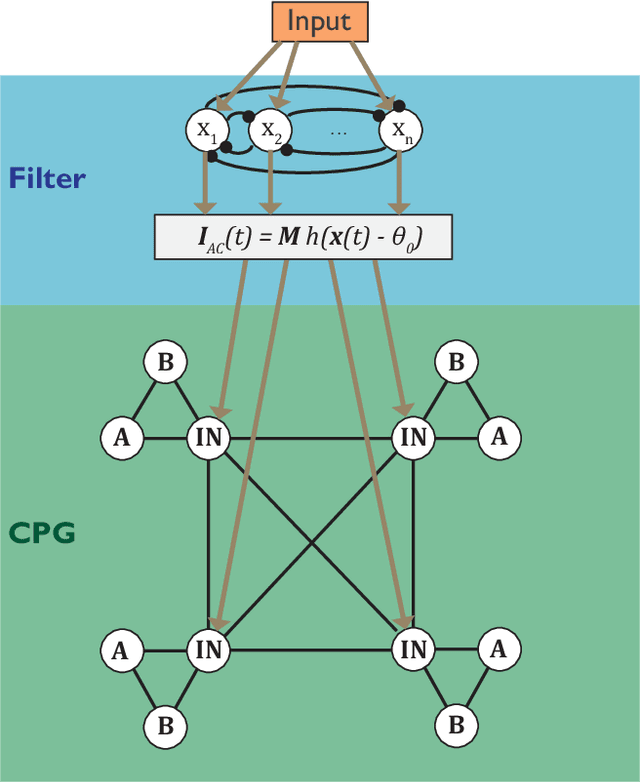
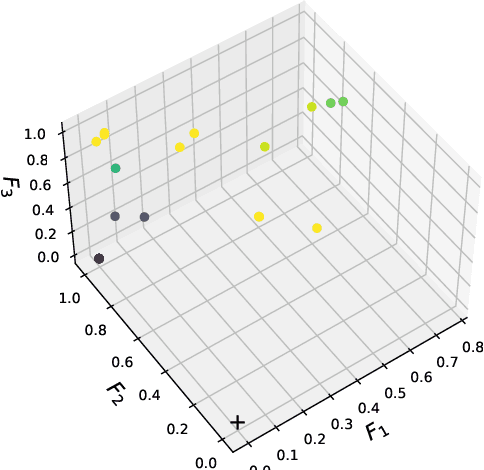
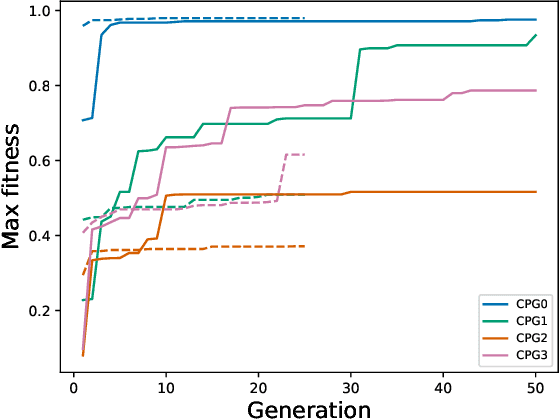
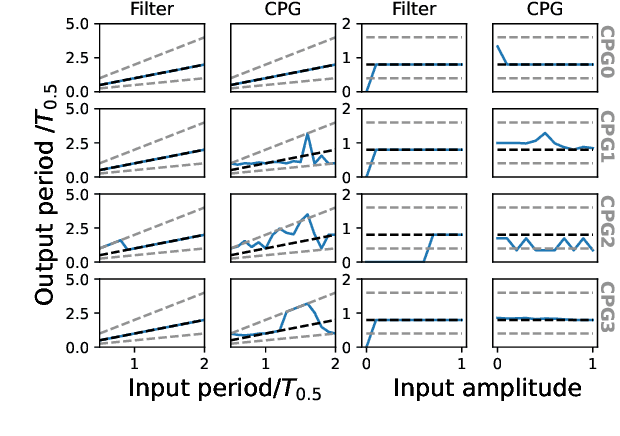
Abstract:Entrainment of movement to a periodic stimulus is a characteristic intelligent behaviour in humans and an important goal for adaptive robotics. We demonstrate a quadruped central pattern generator (CPG), consisting of modified Matsuoka neurons, that spontaneously adjusts its period of oscillation to that of a periodic input signal. This is done by simple forcing, with the aid of a filtering network as well as a neural model with tonic input-dependent oscillation period. We first use the NSGA3 algorithm to evolve the CPG parameters, using separate fitness functions for period tunability, limb homogeneity and gait stability. Four CPGs, maximizing different weighted averages of the fitness functions, are then selected from the Pareto front and each is used as a basis for optimizing a filter network. Different numbers of neurons are tested for each filter network. We find that period tunability in particular facilitates robust entrainment, that bounding gaits entrain more easily than walking gaits, and that more neurons in the filter network are beneficial for pre-processing input signals. The system that we present can be used in conjunction with sensory feedback to allow low-level adaptive and robust behaviour in walking robots.
 Add to Chrome
Add to Chrome Add to Firefox
Add to Firefox Add to Edge
Add to Edge